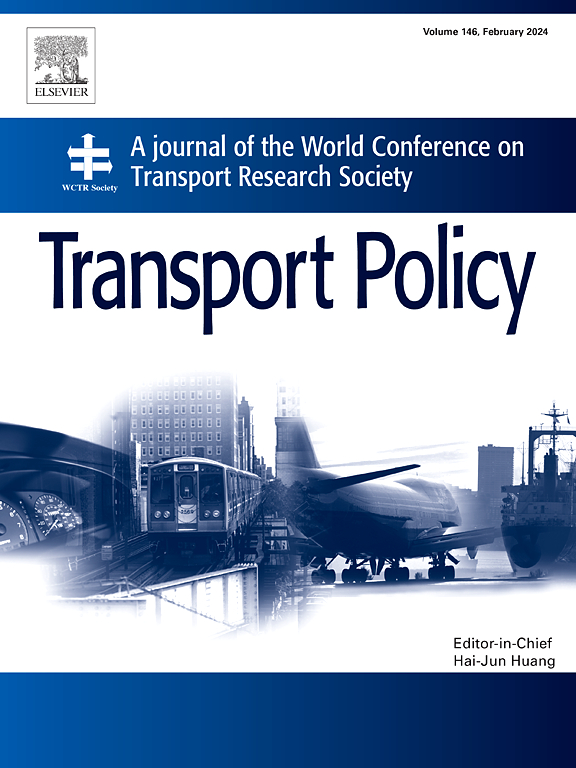物理和社会环境对城市轨道交通服务忠诚度的影响:考虑车站和车厢
IF 6.3
2区 工程技术
Q1 ECONOMICS
引用次数: 0
摘要
尽管许多发展中国家都引入了城市列车服务,但这种公共交通(PT)模式的乘客量仍然很低。为此,城市规划部门正在寻求提高乘客对这些服务忠诚度的方法。然而,现有文献很少研究物质环境和社会环境在提高乘客忠诚度方面的作用。此外,如何在整个乘客体验过程中培养乘客的忠诚度--无论是在车站还是在车上--仍不明确。针对这一空白,本研究基于 "服务质量-满意度-行为意图 "范式和 "刺激-组织-反应"(S-O-R)模型开发了一个模型,以研究在城市列车服务中,车站和列车上的物理和社会环境如何影响乘客的忠诚度。此外,本研究还验证了物理环境和社会环境在此背景下的多维性。本研究使用偏最小二乘法结构方程模型(PLS-SEM)分析了从越南河内城市铁路乘客处收集的数据。研究结果表明,列车上的物质环境和社会环境对城市列车服务的忠诚度有显著影响,而车站环境的影响则不尽相同。此外,车站和列车上的满意度都会对忠诚度产生重大影响,但对列车上体验满意度的影响要比对车站满意度的影响大得多。在实践中,研究结果有助于公共交通管理部门评估现有系统和制定未来的公共交通发展战略。此外,研究还为公共交通服务提供商提供了提高乘客满意度和忠诚度的方法。本文章由计算机程序翻译,如有差异,请以英文原文为准。
The role of physical and social environments on the loyalty toward urban rail services: A consideration of stations and onboard
Although urban train services have been introduced in various developing countries, ridership for this mode of public transport (PT) remains low. In response, urban planning authorities are seeking ways to boost passenger loyalty to these services. However, the existing literature has scarcely examined the role of physical and social environments in fostering passenger loyalty. Additionally, how loyalty is developed throughout the passenger experience - both at stations and onboard - remains unclear. Addressing this gap, the current study develops a model based on the 'service quality-satisfaction-behavioural intentions' paradigm and the Stimulus-Organism-Response (S-O-R) model to examine how the physical and social environments, both at rail stations and onboard trains, impact passenger loyalty in the context of urban train services. Additionally, this study validates the multi-dimensionality of physical environments and social environments in this context. Data collected from urban rail passengers in Hanoi, Vietnam is analyzed using Partial Least Squares Structural Equation Modeling (PLS-SEM). The findings reveal that the physical and social environments onboard trains significantly influence loyalty towards the urban train services, while the environments at stations do not have the same impact. Furthermore, both satisfaction at stations and onboard trains significantly affect the loyalty, though the influence of satisfaction with the onboard experience is much stronger than that of satisfaction with the stations. Practically, the findings assist PT authorities in evaluating existing systems and devising future PT development strategies. Also, the study informs PT providers of ways to improve passenger satisfaction and loyalty.
求助全文
通过发布文献求助,成功后即可免费获取论文全文。
去求助
来源期刊

Transport Policy
Multiple-
CiteScore
12.10
自引率
10.30%
发文量
282
期刊介绍:
Transport Policy is an international journal aimed at bridging the gap between theory and practice in transport. Its subject areas reflect the concerns of policymakers in government, industry, voluntary organisations and the public at large, providing independent, original and rigorous analysis to understand how policy decisions have been taken, monitor their effects, and suggest how they may be improved. The journal treats the transport sector comprehensively, and in the context of other sectors including energy, housing, industry and planning. All modes are covered: land, sea and air; road and rail; public and private; motorised and non-motorised; passenger and freight.
 求助内容:
求助内容: 应助结果提醒方式:
应助结果提醒方式:


